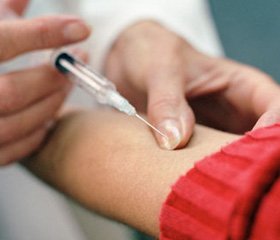Журнал «Здоровье ребенка» 4 (47) 2013
Вернуться к номеру
Today''s problems of vaccinology
Авторы: Bogadelnikov I.V., Kruger Е.А., Bobrysheva A.V., Ilyin, A.V., Smirnov G.I.
Рубрики: Педиатрия/Неонатология
Разделы: Справочник специалиста
Версия для печати
Every year the mass vaccination of children in Ukraine is accompanied cases developing complications of varying severity, without tendency to decrease their number. We characterize some questions to understand the causes of this phenomenon (occurrence of complications of varying severity after the vaccination).
1. The epidemiological situation in the country. In Ukraine today children are born and live in the percolation of two related pandemics: HIV / AIDS and tuberculosis. Causative agents of these infections affect the most basic human defense mechanismsfrom the immune system to the genome. It has been established that children who born to HIV + mothers and had received HAART, react poorly to the DTP, synthesized less JgG slow and immediate type to the toxoid. This untenability of T cells is preserved under 10 years (M.V. Supotnitsky, 2009, 2011). In Ukraine together with the increase HIV - infected patients including women of reproductive age, the number of children born to these women are increased. So, in 1995, was born 99, 1997 - 196, in 2002 - 1379 and 2008 - 5828 children. That is, every year the number of children with defective defense against infections increased and on reaching 1.8 years are removed from the register. However, this is search of contingent that can respond unpredictable reactions - in terms of severity and danger to life, not only for infectious diseases, but also for vaccination.
2. The presence of natural mutations that occur daily during cell division of the human body. All cells of the human body, including the immune cells are dividing. If during cell division occur slight defects caused by replacing one or more nucleotides within a single gene, they are called gene or point, and the death of the organism did not occur. Point mutations causing a change in the structure of proteins, do not lead to immediate death of the body, but always lead to loss of some of their functions. Today's children, we may suspect the presence of point mutations leading to impaired immune system to respond to infection and vaccination. The cause of this response lies in the child, and not in the vaccine, and even more seriously such a child would respond to the very infection.
3. Selective pressure infections. The susceptibility of a person to many pathogens is high. In the 18-19 centuries the majority highly contagious infections exerted selective pressure on the human population, "beating out" (leading to death) the first of those individuals who had immune genetic defects (mutations) that were more or most important. With the development of science humanity has developed methods and tools to help protect themselves from most infectious diseases, prolonging the life of people with certain point mutations, especially in the immune system. So now we are not giving such children die. The number of such children is cumulative.
4. The influence of microorganisms which are in man, at the vaccination (immune) response. The human body is full of bacteria and viruses, without of its it can not exist. But there are search of this whose are presence or activation of a particular time or in special circumstances, consistently decreases immune response to the vaccine or do not response this predictable. To such viruses of the identified now are as exogenous (HIV, the virus in T-cell leukemia) and endogenous (HER V-18, HER VW, HER V-K113 and others) retroviruses.
5. The phenomena of immunological of imprinting and of antibody-dependent amplification of infection, do not take into account either in the process of vaccination or treatment of infectious patients. The phenomena of immunological of imprinting was first described by Fransis, 1953. Its essence lies in that each antigen is a few epitopes (antigen sites, differing from one another), in response to its hit in an organism form chemical heterogeneous antibodies, which differ in their specificity. But, if the antigen clonality is limited, the antigens induce differ little immune responses. When injected another antigen into the body, which has structural similarities to the first, the immune system is responsible for the synthesis of antibodies is not the second, but the first antigen. This leads to increased infection process (antibody to the new pathogen is not produced) and easier spread of the virus in the human population. The phenomenon of antibody-dependent amplification of infection lies in the fact the virus-specific antibodies bind to the virus and by interacting with receptors on the cell surface, not only increasing its penetration into phagocytic cells and, in some cases, and its replication. This phenomenon is characteristic of pathogens HIV, Ebola and Marburg fever, hepatitis C, measles, yellow fever, and others.

